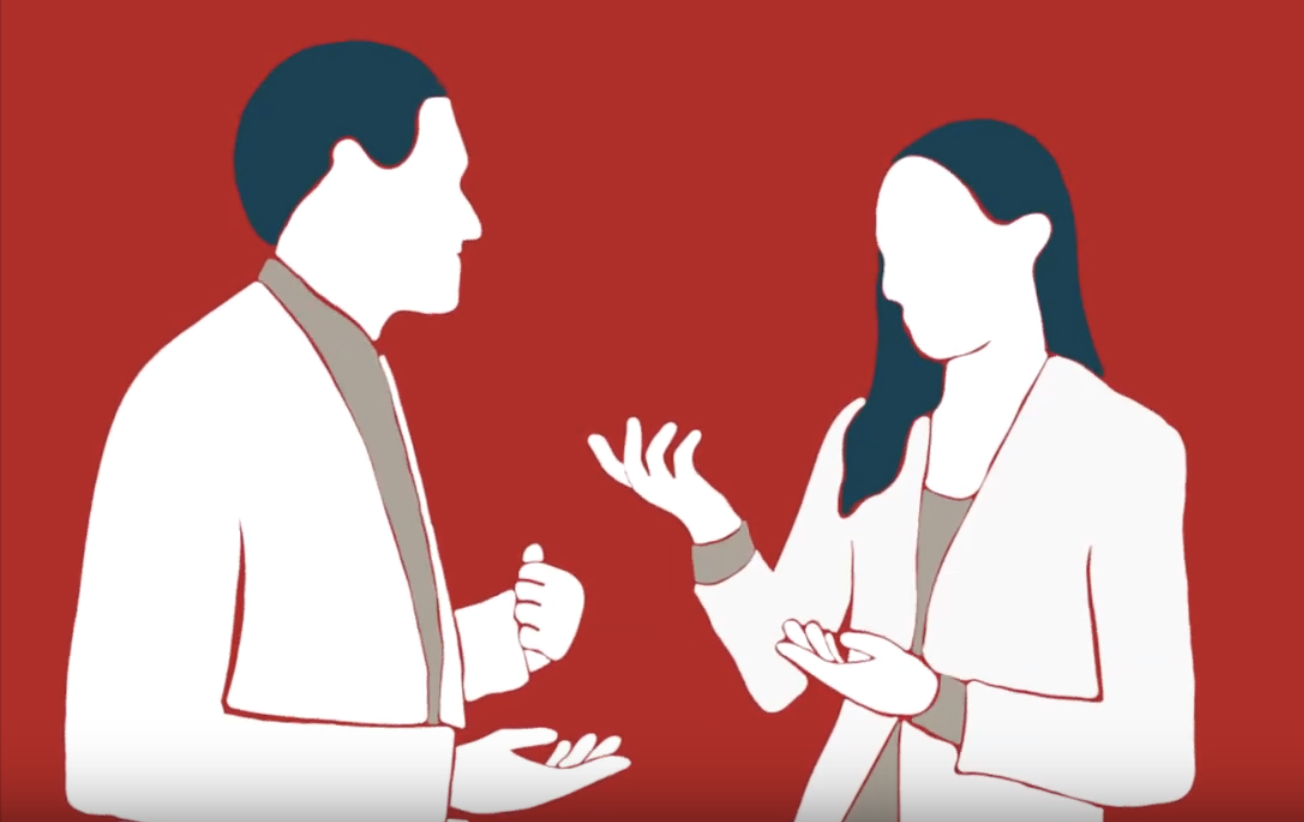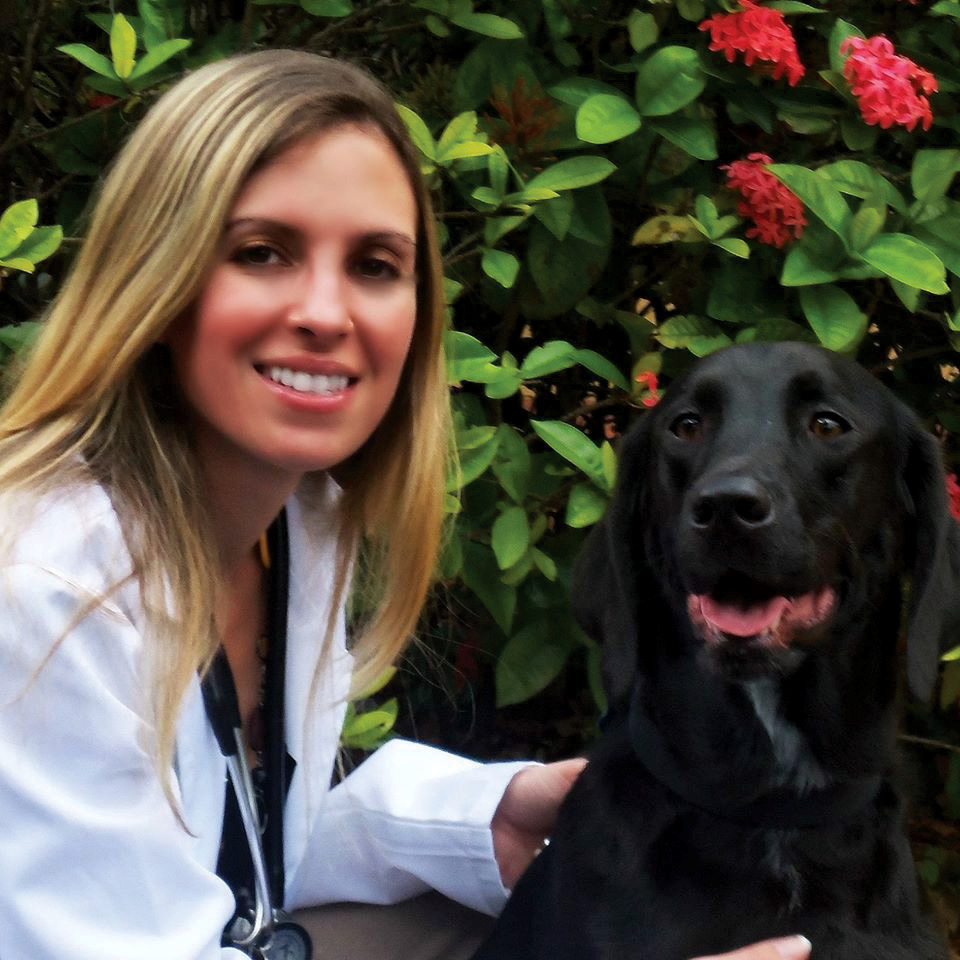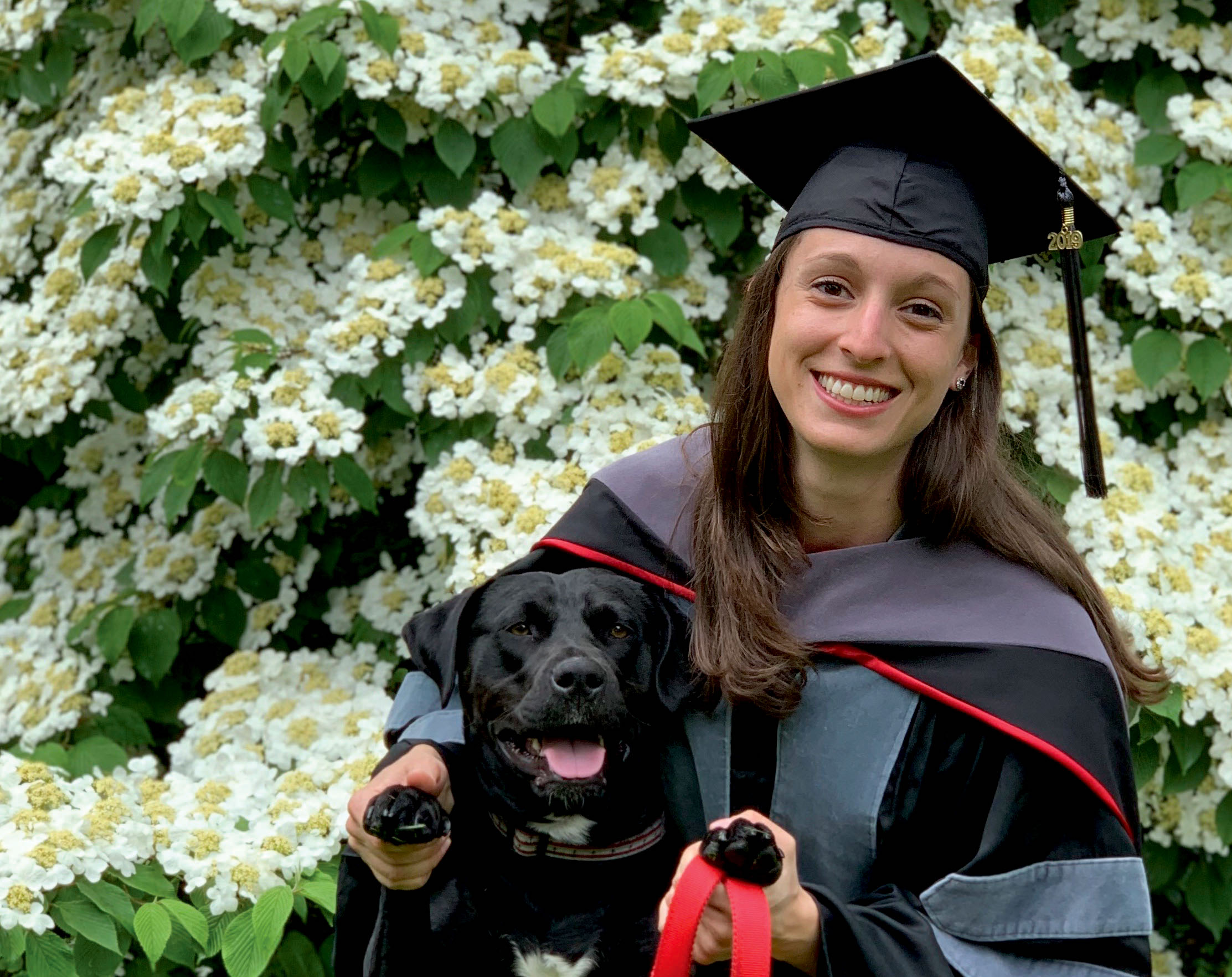The Consult: Nothing to Fear

Kelly Saporito ’02, D.V.M. ’07, and Amari Suskin-Sperry, D.V.M. ’19
Three years after graduating from CVM, Kelly Saporito ’02, D.V.M. ’07, bought her own small animal practice in Florida. The previous owner was unavailable to help her onboard into the business, so the Rochester, New York, native jumped into running the practice with zero support. Amari Suskin-Sperry, D.V.M. ’19, a veterinary student who was in her final semester of veterinary school at the time of this conversation, talked with Saporito about the challenges and excitement of becoming a business owner.
Amari Suskin-Sperry: Was there a pivotal moment that knocked on your door saying you’ve got to own a practice? Or was it a longer, slower process?
Kelly Saporito: I went into private practice and worked for a young female owner. She was just awesome. I loved her. Working with her for three years, I developed my confidence as a practitioner. That’s important to have — or at least it was for me in making the decision to go out on my own. I saw her as an owner and I was like, wow, if she can do this, I can do this.
Suskin-Sperry: I’m actually going right out into the working world after graduation. As a young woman, I find myself lacking a lot of confidence. Do you have any suggestions?
Saporito: It’s a learning process. For me, taking care of an animal is such a serious responsibility. But over time, I was able to gain that confidence just by being partially forced into making decisions. Over time, you see the patients get better with what you’re doing. And that is the strongest reinforcement of all. That’s the coolest feeling in the whole entire world. Whether you’re in an internship or whether you’re out in the real world, I think the process just happens and your confidence will grow.
Suskin-Sperry: How did you then build confidence in your business abilities?
Saporito: Kind of the same thing. I threw myself into it. I took over a failing practice. When I first came in, that was deathly scary. I actually ended up firing a doctor and about 80 percent of my employees six months after I owned the practice. And I ended up finding a veterinarian, like a consulting firm essentially, where they gave me some business management training at that point in time and held my hand through that process.
Suskin-Sperry: Looking back in your veterinary education, were there aspects in your education where you were able to learn about business? Or were you doing that completely on your own?
Saporito: It’s funny, because I wasn’t a part of the business group. I remember we had a couple weeks of business training. I remember it being very interesting. But I don’t know that I was super focused. I’m not really sure that I really prepared myself as well as I should have while I was in college. I think more of it came after the fact.
Suskin-Sperry: When you were in college, did you have a vision at that point that you were going to own? Or was it not till after?
Saporito: It was always in my mind. I would verbalize that to people, like, yeah, I want to own a practice. But it just wasn’t real. I hadn’t really done any planning. I hadn’t really focused energy on it like I had for getting into vet school.
Suskin-Sperry: That takes a lot of energy right there.
Saporito: Yeah, exactly. I really didn’t put very much attention to it at that point in time. It was almost like a switch that flipped, where I was like, hey, this is real now. I’m going to do this.
Suskin-Sperry: Well, you’re very inspiring to me. As a young woman, you don’t see a lot of role models in the ownership world, as young women especially. When you were telling people that you want to own, what were people’s responses to you?
Saporito: It’s funny because I remember very specifically this one guy. I was asking him, “Oh, you own your own business. What’s that like?” And he’s like, “It’s hard. I don’t know that you would want to do it. I work like 80 hours a week.” He was trying to make it sound like it was horrible. And I was just like, hmm, okay. I think I’m going to try to figure out my own opinion about this.
Suskin-Sperry: And how did you not let those voices and your own voice that you mentioned — the voices of fear of huge amounts of responsibility, not only for animals’ lives but I imagine once you took on owning a business, you had people’s livelihoods — how did you not let that fear paralyze you?
Saporito: I think the biggest point when I committed to making the decision, like, I’m going to do this, I’m going to own this practice, I’m going to make this happen — again I had to really look at what is the worst that could happen.
When we’re afraid of something, we’re worried that something bad is going to happen. I was like, what’s the worst? I’m not going to die, so that’s good. And I don’t think I would lose my license either. I think that would be really tough. That would be something medical, and I’m pretty confident with my medical skills.

I don’t have anything to be afraid of. I’m not standing at the top of the building about to fall off. You know? It’s just not that serious. So what if the business fails and then I owe money? I’ll just go work as a vet and pay it off.
And to be honest, it was easier to make the decision about owning the practice because I’m not going to die and I’m not going to kill any animals owning a practice. It was almost like becoming the medical and surgical practitioner part that was scarier, because what’s the worst that can happen? A patient can die.
And that, for me, was a lot worse than a business failing. So actually opening the business was the easier decision of the two. I had to talk myself through it and be like, you’re going to be okay and you’re going to get through this.
It had to come from me. I could listen to people talk to me all day long. And again, what people say to me isn’t really real. It has to come from inside me and I have to believe it.
Suskin-Sperry: So then once you bought into the practice that was failing and you had to make some big decisions, how did that work for you? I’m sure there was a lot of hardship in making those transitions. How was that process?
Saporito: It was so hard. It’s the worst conversation. It’s so stressful and scary. And again, always in my mind it comes down to, oh gosh, what’s going to happen now? What’s next?
But in the beginning, that first step that I took, that was the scariest. And then you just figure it out. I just made some decisions and came out on the other end. And it’s okay.
Suskin-Sperry: So when you went to vet school, did you realize it was going to be all about the people?
Saporito: You know, growing up I worked in an animal hospital since I was 15 years old, so I think I did have a pretty good understanding of that part of it. I saw a lot of what went on. And thankfully I like people. But it does become exhausting at points.
Suskin-Sperry: Yeah. But then also invigorating, right? Because it’s the people that can then turn around and tell you how much of an impact you’ve had on them and their pets’ lives.
Saporito: Exactly.
“I’ve found that, in my experience, it’s very scary to put out money sometimes, but if you’re doing it wisely and it’s an investment in your future, it usually turns out to be a good thing.”
-Kelly Saporito '02, D.V.M. ’07
Suskin-Sperry: My mother’s a therapist and growing up she always said, “Oh, you’d be a great therapist. Are you sure this whole vet thing is what you want to do? You’d be great talking with people.” Since I was six years old, I was set to being a veterinarian. But I’ll tell you what, some days it feels like you’re a therapist, too.
Saporito: I know.
Suskin-Sperry: So it’s a perfect combination.
Saporito: It’s so funny that you say that. We should’ve gotten therapy training on top of it.
What motivated you to want to be a veterinarian and what helped you get to this point that you are in vet school? Since I know that’s not an easy thing to accomplish.
Suskin-Sperry: People always say, wow, you made it to vet school? It’s so hard to get into. And I said, “Well, I thought getting in was hard. Turns out staying in is the hard part.”
It’s been a dream for a very long time for me. And as a kid, I had struggled with anxiety in different ways, and I think animals for me were such a calming mechanism. As I grew up, I struggled with math and science. I remember I was in middle school in a science class and I was really struggling, and I was staying after school to work with our science teacher on a homework assignment. And I said, “How am I going to be a veterinarian if I can’t even do middle school science?” And she said, “Well, maybe you won’t cure the first dog. But you have the determination to keep going and you’ll impact the rest.” That stuck with me in a way — that I wasn’t necessarily the top of the class or the number one science Brainiac, but I had the determination to keep going and making connections.
Saporito: Good for you.
Suskin-Sperry: And the concept of ownership for me, I always liked the idea of being independent and being able to shape my career and how I practice medicine. I’m excited about the concept of ownership later down the road as something that will always push me to reach new heights. And it’ll never be dull.
The first week of vet school, all the clubs have a little booth and tell you a little bit about what they do and how much their dues are and things like that. And there was a veterinary business and management association booth, the VBMA, and I was intrigued because I knew I wanted to be a business owner. But I had never taken any sort of business or accounting or finance class in undergraduate. I was intrigued by it. I called my boyfriend afterwards, I was like, “It’s kind of interesting but their dues are $20 and the rest are like $5. So I don’t think I’m going to do it.”
And he said, “Oh, my gosh, you’ve got to do it. It’s $20, it’s a drop in the bucket with what you owe. Why stop there?”
So I decided to splurge on my $20 dues and the first lecture I went to was a woman, a Cornell alumna, who owns a number of practices in the DC area. Dr. Michelle Vitulli [D.V.M. '91]. And I was totally struck by her, like you, as a young woman that had come out of vet school and been inspired to forge her own path in the veterinary business world.

I went up to her afterwards, like, oh my gosh, I would love to come visit your practices. Well, almost four years later, I’m thrilled to announce that I will be working as one of her associates when I graduate.
Saporito: It’s interesting to hear you talk about the $20, because you’re going to have to make that decision like 97 million more times. I used to cry because I had to spend a large amount of money on something. It was just, oh my god, how am I going to make this work. But yeah, that’s a very valuable lesson that you had already. You saw how that $20 flourished into so much more. I’ve found that, in my experience, it’s very scary to put out money sometimes, but if you’re doing it wisely and it’s an investment in your future, it usually turns out to be a good thing.
Suskin-Sperry: If you had to identify your favorite part of being an owner, what would you say?
Saporito: I think it is the independence and freedom to make my own decisions. I enjoy the business side of things, to switch sides of your brain. I think that’s one of the things, too, I love about veterinary medicine. It’s just as much of an art as it is a science. I find the same thing with business ownership as well. I feel like I’m really coming in here and painting my own picture every day. And the freedom in that is such a wonderful thing.
Suskin-Sperry: That’s such a beautiful way to look at it. When you look back at your Cornell education, what aspects of their curriculum have impacted your role as a business owner?
Saporito: I think Cornell does such an excellent job of fostering independent and critical thinking. It lets you go out on your own, manage your time and independently figure things out. I even recall fourth year, I went to go ask a doctor something. It wasn’t rude or mean, but they were like, well, okay, instead of asking me why don’t you go try to figure it out? And I was like, yeah, good point. So I did. I went and I figured it out on my own. Cornell taught me that principle. And then, Cornell is such a prestigious name. It gives you this respect from clients who know Cornell and understand Cornell. It’s just such a proud feeling to have. To be like, yeah, I made it through vet school at Cornell.
Suskin-Sperry: I look forward to being able to say that.
Saporito: I recall testing for me wasn’t difficult until I got into vet school. They would throw you curve balls and I’d feel like, where is this coming from. I remember feeling so frustrated, but it’s such good preparation for life. In the real world and real veterinary medicine, I can’t tell you the number of times that that happened. And it taught me to pay attention and be ready to catch these curve balls.
Suskin-Sperry: I totally relate. Our first quiz, in Block I, you sit down and the first test question is an owner walks in with a nine-year-old German shepherd and it presents with this issue. What’s the problem? And I’m like — what? How am I supposed to know this? But it was not about the answer, it was all about how do you get to an answer. It didn’t even matter what the diagnosis was. It was so not what I was expecting, and I was so glad it wasn’t just rote memorization and regurgitation.
If you could go back eight years ago before opening the practice, or maybe even back to when you were about to graduate vet school or even start vet school, what could you have told yourself, what you wish you had told yourself, about your future and your role as an owner?
Saporito: Don’t be scared. Don’t be scared. Just do it. Just go out there and experience the world and pay attention. That’s the biggest thing. And learn from your experiences.
Suskin-Sperry: That’s lovely. I’m going to remind myself that.


